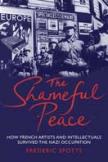Criminal Consent?
Covering this topic is like writing about the 1936 Berlin Olympics: by now the participants are all dead and anyhow none but a handful of stars (Jesse Owens, Pablo Picasso) are known outside the "fan base.” Like track and field events, the doings of painters, actors and writers seem rather trivial alongside the world-shaking traumas and cataclysms of 1936-1945. In any case, history has long since rendered its verdict on both the Olympics and the Occupation: they were, as Frederick Spotts says, borrowing a phrase from the slippery, compromised Jean Cocteau, "shameful.”
Spotts is fittingly described by his publisher as "an independent scholar” who lives in France and has written about Hitler. He takes upon himself the more or less thankless task of surveying a large group of French men and women, some famous but most not, who reacted to their country's catastrophic defeat in familiar and predictable ways. A relative few (Yves Tanguy, Max Ernst, Marc Chagall, Fernand L'eacuteger, Piet Mondrian) fled the country altogether. Another minority, the despised collabos (Louis-Ferdinand Ceacuteline, Robert Brasillach, Pierre Drieu la Rochelle, Alfred Cortot) eagerly welcomed the Germans. But the majority of those surveyed lay low, hoping to continue their creative work more or less as usual. After all, the war was elsewhere, and the Germans wanted to keep France's artistic life humming along to distract the conquered population and maintain an atmosphere of normalcy. Of course, on the broad fringes of the latter body lived a variety of ambiguous types: art-dealers, movie directors, booksellers, theater and opera producers, and some well-known artistes (Maurice Chevalier, Edith Piaf, Fernandel, Marcel Pagnol) who were willing to play along, occasionally or often, with the Vichy regime or the German occupiers.
There were no heroes to be found in this crowd-anyone so inclined could always have gone off to join Malraux, Camus or Saint-Exupeacutery in the Resistance (some of whose members liked to bathe, after the war, in a mythopoetic glow). Otherwise, they had to be attentistes and wait for the storm to pass, perhaps taking comfort in the presumed humanistic value of their paintings, poems, plays, songs, stories and shows. There was an underground press and every now and then, a phrase might slip through the censors, as in the character Garcin's immortal dictum in No Exit (1944), "Hell is other people"-the Germans did not realize that "oles autres” was also a code-phrase for their hated selves. But by definition there was no protest art and, in a culminating twist, while Paris during the war had a busier collection of artists than any other capital city, in the postwar period it lost its world leadership. Served them right?
Unfortunately for Frederick Spotts, none of this qualifies as searing drama and even the eacutepuration, the trials and punishment of artist-collaborators after the Liberation, was a botched affair. Sentences were often arbitrary, with the well-connected, like Maurice Vlaminck or Sacha Guitry or Georges Simenon, getting off easy (they generally claimed to have done a little good on the side, like protect Jews or help to get French P.O.W.s released), while the unlucky, like the soprano Germaine Lubin, who was a personal friend of Peand and had sung for Hitler, were slammed. And some, like Brasillach, were shot. But the legal logic behind the de-Nazification of the artists was never articulated. How could collabos be put to death, when they had never personally caused death or serious harm to anyone-at least not in any measurable way? And, just as with the parallel and much more crucial process in Germany, after an initial burst of zeal, prosecutors decided that national unity, leaving the past behind and fighting Communism were more important so the spineless or worse (fascist, defeatist, anti-Semitic) artists were pardoned. Eventually, visitors might well get the impression that out of the 40 million people in occupied France, practically nobody had been guilty of collaboration.
Spotts has to survey such a huge cast of characters, including many obscure ones (the leftist editor Jean Galtier-Boissi&egraveor, the poet-critic Jean Cassou), that he cannot spend much time on close-ups. He scans the lot deftly and fairly, though in his haste he sometimes slips up. (He calls Proust's mother "partly Jewish,” when Jeanne Weil was all Jewish and he labels Charles Peacutea a "freethinker,” when he was, at least in his mature years, a devout Catholic.) He writes perky, slangy prose ("After exposing himself discreetly [the concert pianist] Cortot then did the full monty”), sprinkled with recherché terms like "cambolesque,” "maledicent,” "alembicated” and "sanguineous.” Oh well, why not?
In the end, the most interesting use of The Shameful Peace might be to provide a detailed frame of reference for philosphical questions. How do you map the murky borderland between culture and politics? In what ways is artistic silence criminal consent? (Picasso and Matisse basically ignored the war as painters.) When does one have to go into exile? And does any of this matter when physical survival is at stake? More than half a century later, the existential answers provided by many of the French do not look very convincing or appealing. But would we have done any better?
This article also appeared in print, under the headline “Criminal Consent?,” in the May 18, 2009, issue.








